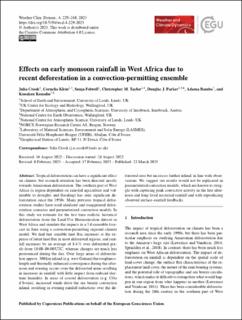| dc.contributor.author | Crook, Julia | |
| dc.contributor.author | Klein, Cornelia | |
| dc.contributor.author | Folwell, Sonja | |
| dc.contributor.author | Taylor, Christopher M. | |
| dc.contributor.author | Parker, Douglas John | |
| dc.contributor.author | Bamba, Adama | |
| dc.contributor.author | Kouadio, Kouakou | |
| dc.date.accessioned | 2023-08-22T10:36:43Z | |
| dc.date.available | 2023-08-22T10:36:43Z | |
| dc.date.created | 2023-06-19T09:58:16Z | |
| dc.date.issued | 2023 | |
| dc.identifier.citation | Weather and Climate Dynamics (WCD). 2023, 4 (1), 229-248. | en_US |
| dc.identifier.uri | https://hdl.handle.net/11250/3085205 | |
| dc.description.abstract | Tropical deforestation can have a significant effect on climate, but research attention has been directed mostly towards Amazonian deforestation. The southern part of West Africa (a region dependent on rain-fed agriculture and vulnerable to droughts and flooding) has seen significant deforestation since the 1950s. Many previous tropical deforestation studies have used idealized and exaggerated deforestation scenarios and parameterized convection models. In this study we estimate for the first time realistic historical deforestation from the Land-Use Harmonization dataset in West Africa and simulate the impacts in a 5 d ensemble forecast in June using a convection-permitting regional climate model. We find that sensible heat flux increases at the expense of latent heat flux in most deforested regions, and rainfall increases by an average of 8.4 % over deforested pixels from 18:00–06:00 UTC, whereas changes are much less pronounced during the day. Over large areas of deforestation approx. 300 km inland (e.g. west Guinea) the roughness-length and thermally enhanced convergence during the afternoon and evening occurs over the deforested areas resulting in increases in rainfall with little impact from reduced daytime humidity. In areas of coastal deforestation (e.g. Côte d'Ivoire), increased winds drive the sea breeze convection inland, resulting in evening rainfall reductions over the deforested area but increases further inland, in line with observations. We suggest our results would not be replicated in parameterized convection models, which are known to struggle with capturing peak convective activity in the late afternoon and long-lived nocturnal rainfall and with reproducing observed surface–rainfall feedbacks. | en_US |
| dc.language.iso | eng | en_US |
| dc.rights | Navngivelse 4.0 Internasjonal | * |
| dc.rights.uri | http://creativecommons.org/licenses/by/4.0/deed.no | * |
| dc.title | Effects on early monsoon rainfall in West Africa due to recent deforestation in a convection-permitting ensemble | en_US |
| dc.title.alternative | Effects on early monsoon rainfall in West Africa due to recent deforestation in a convection-permitting ensemble | en_US |
| dc.type | Peer reviewed | en_US |
| dc.type | Journal article | en_US |
| dc.rights.holder | © Author(s) 2023 | en_US |
| dc.description.version | publishedVersion | en_US |
| cristin.ispublished | true | |
| cristin.fulltext | original | |
| cristin.qualitycode | 1 | |
| dc.identifier.doi | 10.5194/wcd-4-229-2023 | |
| dc.identifier.cristin | 2155668 | |
| dc.source.journal | Weather and Climate Dynamics (WCD) | en_US |
| dc.source.volume | 4 | en_US |
| dc.source.issue | 1 | en_US |
| dc.source.pagenumber | 229-248 | en_US |

